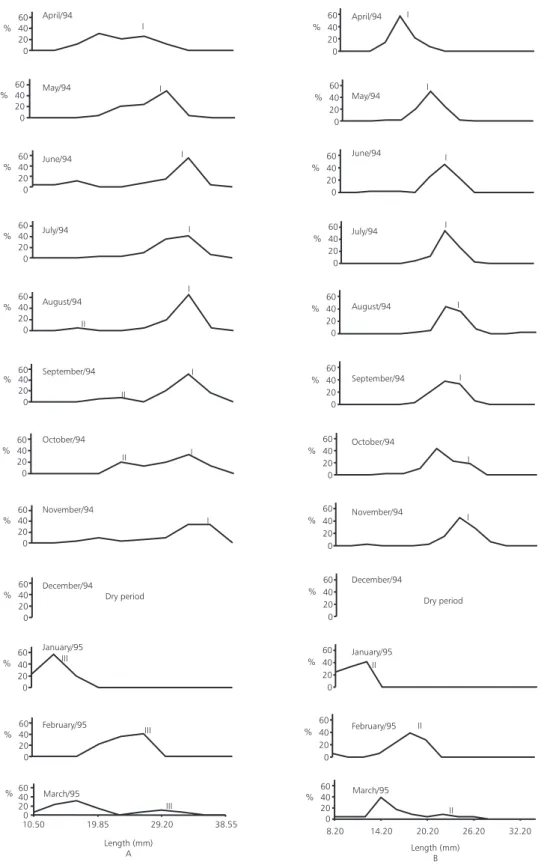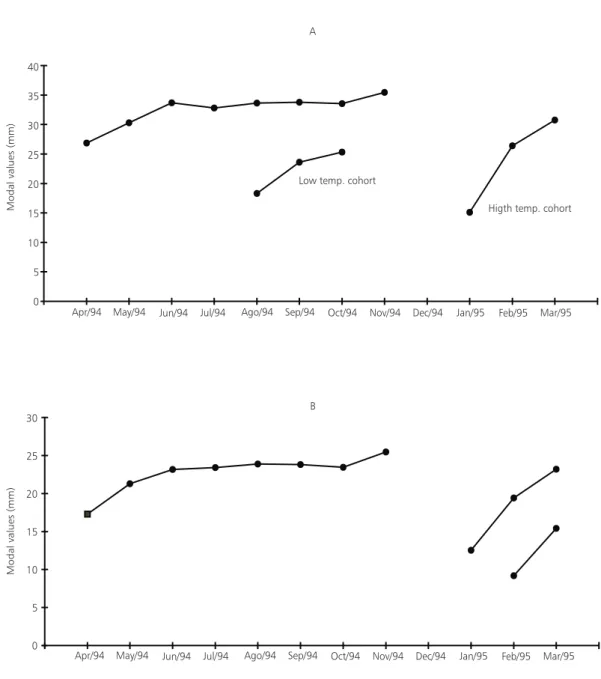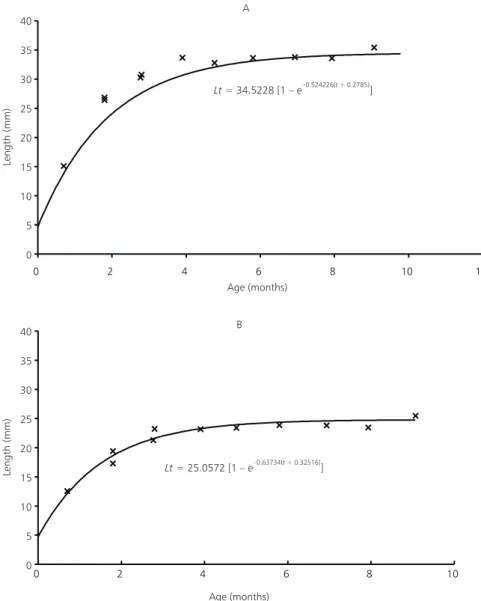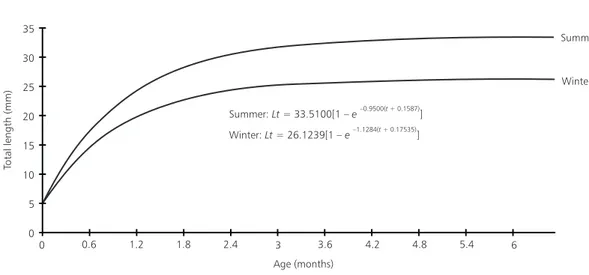GROWTH OF THE ANNUAL FISH
Cynopoecilus
melanotaenia
(REGAN, 1912) BASED IN A TEMPORARY WATER BODY
POPULATION IN RIO GRANDE DO SUL STATE, BRAZIL
(CYPRINODONTIFORMES, RIVULIDAE)
ARENZON, A., PERET, A. C. and BOHRER, M. B. C.
Centro de Ecologia, Universidade Federal do Rio Grande do Sul, C.P. 15007, CEP 91501-970, Porto Alegre, RS, Brazil
Correspondence to: Alexandre Arenzon, Universidade Federal do Rio Grande do Sul, Av. Ijuí, 560/202, CEP 90460-200, Porto Alegre, RS, Brazil, e-mail: alex@ecologia.ufrgs.br
Received October 5, 1999 – Accepted February 16, 2000 – Distributed February 28, 2001
(With 4 figures)
ABSTRACT
The growth of the annual fish Cynopoecilus melanotaenia was studied in its natural environment, in order to obtain information about its biology. A total of 797 specimens of C. melanotaenia were collected on a monthly basis between April 1994 and March 1995 in a temporary water body, located in Rio Grande do Sul State, Brazil. The growth curve in total length suggests, to both sexes, a fast initial growth. Males present a smaller growth rate than females, but they attain a higher average maximum length than the females.
Key words: annual fish, growth, Cynopoecilus melanotaenia, Brazil.
RESUMO
Crescimento do peixe anual Cynopoecilusmelanotaenia (Regan, 1912) com base na população de um corpo d’água temporário do Rio Grande do Sul, Brasil
(Cyprinodontiformes Rivulidae)
O crescimento do peixe anual Cynopoecilus melanotaenia foi estudado em seu ambiente natural, visando obter informações referentes a sua biologia. Foram capturados 797 espécimes de C. melanotaenia, em coletas mensais entre abril de 1994 e março de 1995, em um corpo d’água temporário localizado no Estado do Rio Grande do Sul, Brasil. A curva de crescimento total sugere, para ambos os sexos, um rápido crescimento inicial. Os machos apresentam uma taxa de crescimento menor que a das fêmeas, mas atingem, em média, um comprimento máximo maior que o das fêmeas.
Palavras-chave: peixe anual, crescimento, Cynopoecilus melanotaenia, Brasil.
INTRODUCTION
Annual fish are defined as a group of Cypri-nodontiformes fish that can be found in temporary ponds, ditches and mudholes occurring in some parts of South America and Africa that dry out seasonally (Myers, 1942). The complete drying out of that aquatic habitat leads to the death of all adult and juvenile fish. The population survives as buried eggs for up to 18 months (Wourms,
1972). When the next rainy season comes, a new reproductive cycle begins, ponds refill and embryos hatch. The larval fish rapidly grow, become se-xually mature and spawn repeatedly over a long period (Myers, 1942, 1952; Carvalho, 1957; Wal-ford & Liu, 1965; Lacerda, 1969; Costa, 1990; Arenzon, 1996).
to the species to be used in toxicity tests. Some species can even become sexually mature after six-eight weeks of life (Vaz-Ferreira et al., 1964; Walford & Liu, 1965; Weitzman & Wourms, 1967; Arenzon, 1996). The use of annual fish as test organisms in toxicity test may solve the problems of this kind of biomonitoring, the continuous cul-turing and/or recruitment of live stocks of test organisms, in a healthy state and in sufficient num-bers.
The culture of organisms in the laboratory implies previous knowledge of biological characte-ristics such as the reproduction and growth of the species. The present study aims to establish some information on the growth of C. melanotaenia.
MATERIAL AND METHODS
From April, 1994 to March, 1995, specimens of C. melanotaenia were collected in a temporary water body, located in Tramandaí municipality, in the north of the Coastal Plain of Rio Grande do Sul State, Brazil (29o58’48” and 29o58’54”S; 50o 14’12”
and 50o14’20”W). Specimens were collected
mon-thly using a hand net of 2 mm mesh. No specimens were collected during December 1994, when the water body was dry. The total length (mm) of each specimen was determined using a sliding calliper (0.5 mm) for specimens with a length higher than 100 mm, and stage micrometer in a microscope for smaller ones.
The population structure in length described here was determined based on the analysis of fre-quency distribution of total length classes by the Petersen method (Bagenal, 1968). These data were plotted monthly, for males and females separately. The growth curves in total length for each sex were obtained by Bertalanffy (1938) expression, after it had been validated by the Ford-Walford trans-formation (Walford, 1946). A total of 19 specimens hatched in the laboratory and obtained from spawning of specimens from the studied population, also kept in laboratory, were used to estimate the length of new born fries.
According to Lacerda (1969), annual fish eggs begin its hatch immediately after the raining season. Thus, it was possible to estimate the age of the specimens collected on the months subse-quent to the dry spell period (December).
Data from the nearest meteorological station indicate that the raining season started 21 days
before the January collection. This information confers the specimens collected in this period the maximum age of 21 days, as no specimen was previously present in the water body.
For the specimens collected after January, the age was determined adding the number of days between each collection period to the 21 initial days.
The age of the specimens collected on the period before the drying period was made com-paring the modal length from this period with the modal length obtained after the drying season.
RESULTS
The monthly displacement of modes, both for male (Fig. 1A) and for female (Fig. 1B) confirms the adequacy of using Petersen method for this study.
The obtained modal values demonstrate a fast initial growth in both sexes (Fig. 2). The average individual length at birth, estimated in laboratory, was 4.69 mm, with a standard deviation of 0.258 mm (VC = 5.5%).
The Bertalanffy length of mathematical expressions curves for males (Fig. 3A) and females (Fig. 3B) of C. melanotaenia, show a smaller growth rate for males (K = 0.5243) when compared for females (K = 0.6373). Males attain an average maximum length (L∞) higher than females.
The appearance of modes of new cohorts in the population of males (Fig. 1A) was observed in August-October. The temporal displacement of these modes allowed the analysis of the growth of these cohorts separately, during the coldest and hottest period. The coldest period (August-October) showed average water column temperature of 17.3oC and the hottest (January-March) showed
average water column temperature of 25.5oC. The
statistics analysis showed no significative difference (p = 0.05) on the growth rate between the two cohorts (Fig. 4).
DISCUSSION
60 40 20 0 April/94 April/94 I % 60 40 20 0 May/94 May/94 I % 60 40 20 0
June/94 I June/94
%
60 40 20 0
July/94 I July/94
% 60 40 20 0 August/94 August/94 I II % 60 40 20 0 September/94 September/94 I II % 60 40 20 0 October/94 October/94 I II % 60 40 20 0 November/94 November/94 I % 60 40 20 0 December/94 December/94
Dry period Dry period
% 60 40 20 0 January/95 III % 60 60 60 60 60 60 60 60 60 60 40 40 40 40 40 40 40 40 40 40 20 20 20 20 20 20 20 20 20 20 0 0 0 0 0 0 0 0 0 0 February/95 III % % % % % % % % % % 60 40 20 0 March/95 III % January/95 60 40 20 0 % II 60 40 20 0 February/95 % II 60 40 20 0 % March/95 II I I I I I I I I
10.50 19.85 29.20 38.55
Length (mm) A
8.20 14.20 20.20 26.20 32.20
Length (mm) B
Fig. 1 — Monthly length-frequency distribution (mm) of males (A) and females (B) of Cynopoecilusmelanotaenia,
Although the reproduction of C. melanotaenia is not periodic (Arenzon, 1996), annual fish eggs are “stocked” at the bottom, hatching when the abiotic conditions become favourable again. This process makes the hatch of C. melanotaenia to occur in batches, producing different cohorts. Thus, in most cases, instead of the presence of multi-modals curves, we found each month a uni-modal curve
representative of the same age class, which moved itself along the time. According to Santos (1978) the modes represent natural age classes, that is it, a group of specimens from the same spawn or from the same period of the year when the spawning process was more intense. In C. melanotaenia case, the modes represent groups of specimens resultant of the same hatch, but from different spawning.
30
20
10 25
15
5
0
Apr/94 May/94 Jun/94 Jul/94 Ago/94 Sep/94 Oct/94 Nov/94 Dec/94 Jan/95 Feb/95 Mar/95 B
Higth temp. cohort Low temp. cohort
40
30
20
10 35
25
15
5
0
Apr/94 May/94 Jun/94 Jul/94 Ago/94 Sep/94 Oct/94 Nov/94 Dec/94 Jan/95 Feb/95 Mar/95 A
Modal
values
(mm)
Modal
values
(mm)
Fig. 2 — Length modal values for (A) males and (B) females of Cynopoecilusmelanotaenia, collected from April/94 to
The male growth in the summer and winter periods shows no significative difference on the temperature influence on the growth of C. mela-notaenia, at last during the very short observed period of each cohort. Walford & Liu (1965) and Liu & Walford (1966), based in laboratory expe-riments, reported that studies with sexually mature Cynolebias adloffi, a closely related species (Costa, 1990) showed that faster growth occurred at a lower temperature (16oC vs. 22oC). Liu & Walford (1969,
1970) also observed that Cynolebias bellottii was able to attain a very large size in less than one
month, at relatively high temperatures (22 to 32oC).
According to Liu & Walford (1970) and Liu et al. (1975) the higher growth of annual fish at lower temperature could be related to a more efficient food conversion in this condition, thus energy conversion becomes more efficient with the same amount of food at a lower than a higher tempe-rature. These last authors comment that the faster growth of annual fish in natural conditions, on higher temperature, could be resulting from a large food availability, enough to keep a good growth rate.
0 2 4 6 8 10 12
40
35
30
25
20
15
10
5
0
Lt= 34.5228 [1 –e–0.524226( + 0.2785)t ]
Age (months)
Length
(mm)
Length
(mm)
0 2 4 6 8 10
40
35
30
25
20
15
10
5
0
Lt= 25.0572 [1 –e–0.63734( + 0.32516)t ]
Age (months) B
A
Besides, we should add here that the higher day length during the hottest months, allows a longer feeding period.
Thus, according to our data, C. melanotaenia shows a very fast growth, having the possibility of growing close to the maximum length in the period of three months. This characteristic favours its cultivation in laboratory conditions, as fast body growth is usually related to a precocious sexual maturity.
Acknowledgments – To Sandra M. Hartz, Liane B. Printes and Claudine Gus for critics, suggestions and help.
REFERENCES
ARENZON, A., 1996, Biologiaeecologiado peixeanual
Cynopoecilus melanotaenia (Regan, 1912)visandoseu usocomoorganismo-testeemtestesdetoxicidade (Cypri-nodontiformes,Rivulidae). M. Sc. thesis, Univ. Federal do Rio Grande do Sul, 118p.
BAGENAL, T. B., 1968, MethodsofAssessmentoffish pro-duction infresh waters. Blackwell Scientific Publica-tions, Oxford, 365p.
BERTALANFFY, L. Von, 1938, A quantitative theory of organic growth. HumanBiology, 10: 181-213. CARVALHO, A. L., 1957, Notas para o conhecimento da
biologia dos peixes anuais. Rev. Brasil.Biol., 17: 459-466.
COSTA, W. J. M., 1990, Análise filogenética da família Rivulidae (Cyprinodontiformes, Aplocheiloidei). Rev. Brasil. Biol., 50: 65-82.
LACERDA, T. P., 1969, Estudossobreospeixesanuaisda regiãodeSãoLeopoldo. Dissertation, Univ. do Vale do Rio dos Sinos, São Leopoldo, 65p.
LIU, R. K. & WALFORD, R. L., 1966, Increased growth and life-span with lowered ambient temperature in the annual fish Cynolebiasadloffi. Nature, 212: 1277-1278. LIU, R. K. & WALFORD, R. L., 1969, Laboratory studies
on life-span, growth, aging, and pathology of the annual fish Cynolebiasbellotti Steindachner. Zoologica,54: 1-19.
LIU, R. K. & WALFORD, R. L., 1970, Observations on the lifespans several species of annual fishes and of the world’s smallest fishes. Exp.Geront., 5: 241-246. LIU, R. K., LEURG, B. E. & WALFORD, R. L., 1975,
Ef-fect of temperature-transfer on growth of laboratory po-pulation of a South American annual fish Cynolebias bellottii. Growth, 139: 337-343.
MYERS, G. S., 1942, Studies on South American fresh-water fishes. Stanford Ichthyol.Bull., 2: 84-114.
MYERS, G. S., 1952, Annual fishes. Aquar.J., 23: 125-141. SANTOS, E. P. dos, 1978, Dinâmicadepopulaçõesaplicada àpescaepiscicultura. Hucitec-Edusp, São Paulo, 129p. VAZ-FERREIRA, R., SIERRA de SORIANO, B. & SCAGLIA de PAULETE, S., 1964, Eco-etología de la reproducción en los peces del género Cynolebias
Steindachner, 1876. Arch. Soc.Biol.Montevideo, 26: 44-49.
WALFORD, L. A., 1946, A new graphic method of descri-bing the growth animals. Biol. Bull. Mar.Biol.Lab., 90: 141-147.
WALFORD, R. L. & LIU, R. K., 1965, Husbandry, life-span and growth rate of the annual fish, Cynolebiasadloffi.
Exp.Geront., 1: 161-171. Summer:Lt= 33.5100[1 –e–0.9500( + 0.1587)t ]
Winter:Lt= 26.1239[1 –e–1.1284( + 0.17535)t ]
0 0
0.6 1.2 1.8 2.4 3 3.6 4.2 4.8 5.4 6
5 10 15 20 25 30 35
Age (months)
Summer
Winter
Total length (mm)
Fig. 4 — Length growth curves for summer and winter male cohorts of Cynopoecilusmelanotaenia. Collected from April/
WEITZMAN, S. H. & WOURMS, J. P., 1967, South Ameri-can cyprinodont fishes allied to Cynolebias with the description of a new specie of Austrofundulus from Vene-zuela, Copeia,1: 89-100.
WOURMS, J. P., 1967, Annual Fishes. In: F. W. Wilt & N. K. Wessells (eds.), MethodsinDevelopmentalBiology.
Thomas Y. Crowell Co., New York, 137p.
WOURMS, J. P., 1972, Developmental biology of annual fi-shes. III. Pre-embryonic and embryonic diapause of variable duration in the eggs of annual fish. J.Exp.Zool.,



